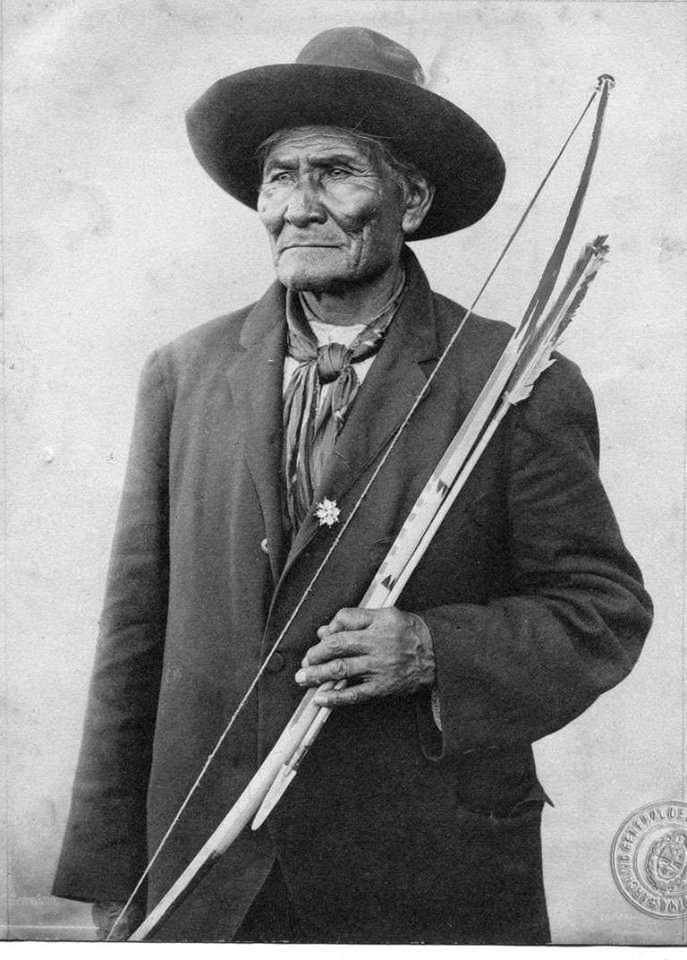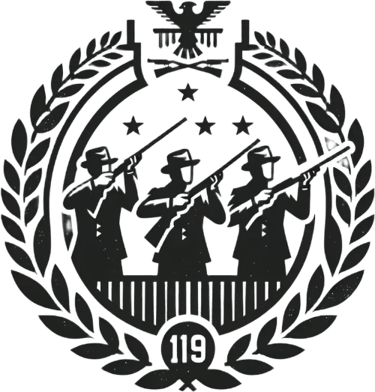Geronimo: The Legendary Apache Shooter
The Arrow That Flew Through the Flames
HISTORIER
3/15/20256 min read


The Arrow That Flew Through the Flames
Dusk settled over the Sierra Madre mountains in 1881. The small group of Mexican soldiers had made camp in a cluster of cacti and mesquite trees, convinced they had finally distanced themselves from the Apaches who had pursued them for three days. By the campfire sat Captain José Maria Carrasco, the same officer who two years earlier had led the massacre of an Apache village where Geronimo's wife, mother, and three small children were killed.
The soldiers did not know they were being observed – that Geronimo and twenty Chiricahua Apache warriors had followed them through the desert landscape like shadows. Now they lay spread in a semicircle around the camp, motionless in the growing darkness.
Geronimo, 58 years old at this point, but still with a warrior's sharp eyes and steady hand, held his favorite rifle – a Winchester Model 1876 that he had taken from a dead American rancher the year before. He was known among both Apache and whites as a remarkable marksman, but his most special skill was in true Apache traditions – the archery he had mastered since childhood.
This evening, Geronimo would demonstrate a shooting skill that was later recorded in both Apache oral tradition and in Mexican military reports.
When the soldiers had eaten and begun to settle down to sleep, with only two guards standing, Geronimo took out a special arrow from his quiver. The arrow was made of an especially strong arrow shaft from the desert, with a tip of volcanic obsidian – black glass – sharper than surgical steel. But what was unique about this arrow was what was attached behind the tip: a small canvas pouch filled with dry gunpowder stolen from a Mexican ammunition storage.
In faint moonlight, Geronimo drew his powerful bow, made of mulberry wood and reinforced with sinew. He took aim, not at the soldiers, but at the campfire itself.
According to the account from Daklugie, an Apache warrior who was present, Geronimo shot the arrow in a high arc. It sailed through the night sky and hit perfectly in the middle of the campfire, where it exploded with a loud bang as the gunpowder ignited. Flames and sparks shot in all directions, and in the confusion that followed, the Apaches attacked.
The most remarkable aspect of the shot was not just its dramatic effect, but the extraordinary precision it required. Hitting a campfire from over 100 meters in faint moonlight, with an accuracy that ensured the gunpowder would ignite, required a combination of judgment, technique, and natural talent that few shooters have ever possessed.
The Winchester That Spoke With Thunder
A lesser-known, but equally remarkable story about Geronimo's shooting skills comes from an incident in 1885, documented by Lieutenant Britton Davis, one of the American officers who was assigned to monitor Geronimo during his brief period at the San Carlos Reservation.
Davis, who later wrote the book "The Truth About Geronimo," described an incident where he challenged Geronimo to a shooting competition. Davis was himself known as an excellent marksman, and he proposed a competition with rifles at 200 yards.
To Davis's surprise, Geronimo accepted immediately, and chose his Winchester Model 1876 in caliber .45-75. Davis used a newer, more accurate Springfield .45-70 military rifle with target sights.
Davis set up a standard military target and demonstrated his skill by placing five shots within an 8-inch circle. He noted with satisfaction that most of Geronimo's men looked impressed.
When it was Geronimo's turn, he did something unexpected. Instead of shooting at the target, he pointed to a steep hillside about 250 yards away, where a small white limestone formation protruded. "I shoot at that," he said through an interpreter.
Davis protested that this was not a standard target and that the distance was greater than agreed, but Geronimo had already taken up his shooting position. With a fluid motion, he raised the rifle, aimed quickly, and fired five shots so rapidly that they almost sounded like one long rumble.
Stone fragments sprayed from the limestone target with each shot. When they later inspected the target, they found that all five bullets had hit within an area less than seven inches in diameter – a remarkable achievement even with modern precision weapons, and almost miraculous with a Winchester Model 1876, which was known to be powerful but not particularly accurate.
What made the performance even more impressive, Davis noted, was that Geronimo shot from a standing position, without support, with lightning-fast trigger pulls, and that he had chosen a natural target instead of an artificial one. This illustrated a fundamentally different approach to shooting – not as a sport discipline with rigid rules, but as a practical skill developed through lifelong hunting and warfare.
Davis concluded his account with a remarkable observation: "I have shot with master marksmen from the army and with civilian champion shooters. I have never seen anyone shoot faster or more accurately than Geronimo with a weapon he was familiar with."
The Mysterious Mountain Lion Hunt
A third story about Geronimo's shooting skills blends practical abilities with the spiritual beliefs that shaped his life and warfare.
In 1884, while on the reservation under strict surveillance, Geronimo was granted permission to go deer hunting, accompanied by two cavalry soldiers. Jason Betzinez, an Apache who later wrote one of the few firsthand accounts of life with Geronimo, was on this hunt and documented the event.
The group had hunted all day without success when they came across fresh tracks of a large mountain lion (also known as cougar). The soldiers wanted to ignore the tracks and continue deer hunting, but Geronimo insisted on following the mountain lion.
"Mountain lion is powerful medicine," he explained. "He who kills a mountain lion with one shot will receive power."
The soldiers, skeptical but curious, reluctantly followed as Geronimo tracked the mountain lion through dense brush and up into a mountainous area. After several hours of intense tracking, Geronimo suddenly stopped and pointed toward a cluster of rocks almost 300 yards away.
Neither the soldiers nor Betzinez could see anything, but Geronimo raised his rifle and took aim at what looked like just a collection of shadows and rocks.
"The mountain lion is there," he said calmly. "It sleeps under the overhang. Only the eyes are visible."
He fired once. The echo of the shot rolled through the valley, and to the soldiers' astonishment, they heard the unmistakable sound of a large animal falling heavily to the ground.
When they reached the spot, they found an enormous male mountain lion, hit right between the eyes – an almost impossible shot given the distance, the poor light, and the limited target.
What made the story particularly remarkable was Geronimo's explanation. He claimed that he had not shot the mountain lion based on sight alone, but that he had used "power" – the spiritual force that Apache shamans like himself believed they could channel.
"I did not see only with these," he said, pointing to his eyes. "I saw with these also," and pointed to his heart. This combination of extraordinary physical skill and deep spiritual conviction was at the core of Geronimo's legendary status among both his people and his enemies.
Betzinez noted that even the skeptical soldiers were speechless, and one of them reportedly said: "No white man could have made that shot. Not even Buffalo Bill."
The Legacy: Truth and Legend
The stories of Geronimo's shooting skills must of course be understood in their historical context. Some details may have been enhanced through oral tradition, and it is difficult to fully separate what is historically accurate and what is legend-building.
Nevertheless, there is broad agreement among historians about some fundamental facts:
Geronimo was an exceptional marksman with both traditional Apache weapons and with firearms he acquired later in life. His ability to master the primitive rifles of the 19th century was remarkable, especially considering that he first began using rifles regularly in well into adulthood.
His skills were not coincidental but the result of lifelong discipline and practice. For the Apache, hunting and warfare were not just practical activities but deeply integrated parts of their cultural and spiritual identity. Geronimo trained his body and skills from early childhood with an intensity that few modern shooters can compare with.
What truly distinguished Geronimo from other skilled shooters was the context of his achievements. He demonstrated his abilities not on shooting ranges or in controlled environments, but under extreme conditions – during pursuit, in war situations, in harsh terrain, and often under intense climatic challenges in the American southwest desert.
Even his most dedicated enemies acknowledged his extraordinary skills. General George Crook, one of the most experienced "Indian fighters" and a man who hunted Geronimo for years, wrote in his memoirs: "He shot with a precision that seemed supernatural, especially considering the speed with which he could fire."
When Geronimo finally surrendered to the American military in 1886, it marked the end of the last major resistance struggle by the indigenous people in the American southwest. He spent the rest of his life as a prisoner of war and died at Fort Sill, Oklahoma in 1909. But even in his last years, when he was in his 80s, according to eyewitnesses, he still demonstrated remarkable precision when he was allowed to shoot.
In his autobiography, dictated near the end of his life, Geronimo summarized his approach to warfare with words that also perfectly describe his philosophy of shooting: "We were born in this country and had learned to hit moving targets from horseback with bow and arrow, and we rarely missed... We learned to endure, to avoid complaining in the worst situations, to move quickly and quietly, and to travel long distances with minimal rest or food."
Perhaps this is the most enduring legacy of Geronimo's shooting skills – not just technical achievement, but the integration of skill, endurance, cultural knowledge, and spiritual practice in a holistic approach to shooting that few marksmen in history have surpassed.
Historic Shooters
Explore stories about the most remarkable shooters and their incredible achievements.
Biografier
geir@otimo.no
© 2025. All rights reserved.
